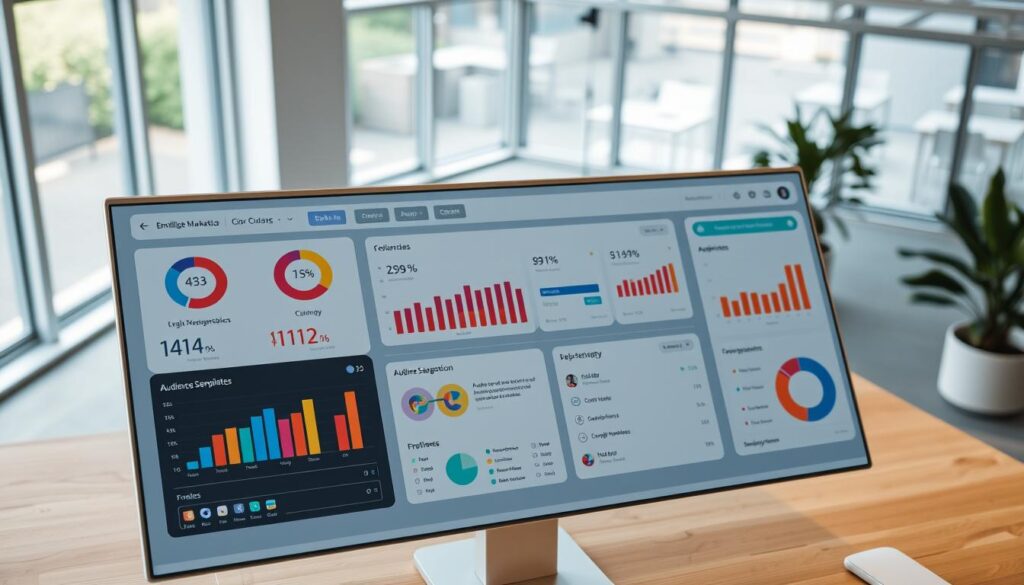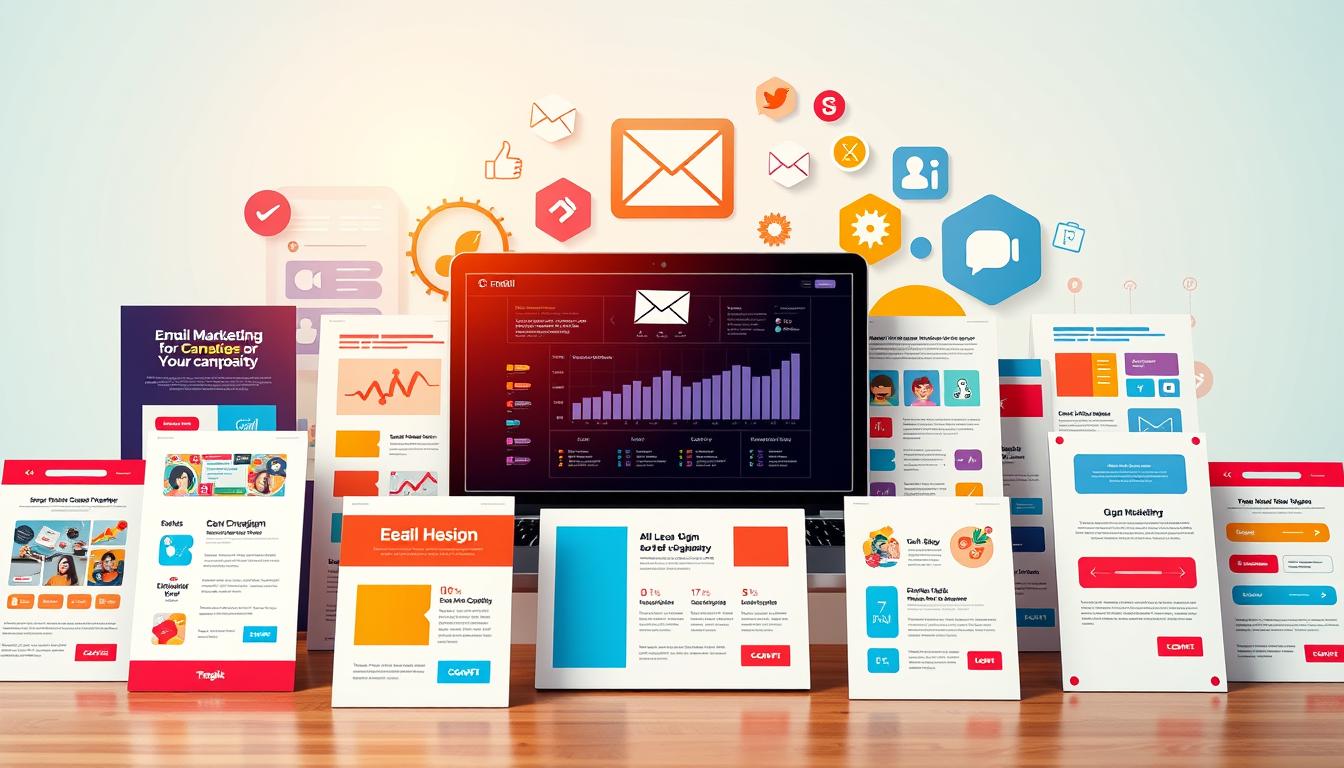In today’s world, a good email marketing strategy is key for businesses to do well. It helps build strong bonds with customers, makes your brand known, and boosts sales.
A strong email marketing plan lets businesses stay ahead and reach their goals. This article will show you how to make an email marketing strategy that speaks to your audience.
Power of Email Marketing in Today’s Digital Landscape
Email marketing is key in digital marketing, offering great ROI. It lets businesses talk directly to their audience. This makes the experience more personal and fun.
ROI and Effectiveness Statistics
Email marketing is known for its high return on investment. For every dollar spent, the average return is $42. This shows how well email campaigns can work. By using email campaign optimization, businesses can get even better results.
How Email Complements Other Marketing Channels
Email marketing works well with other channels like social media and content marketing. It helps spread the message, bringing more people to websites. Through email metrics analysis, marketers learn more about their customers. This helps them improve their marketing plans.
Defining Strategic Goals for Your Email Campaigns
To make your email marketing better, you need clear goals. This step makes sure your emails match your business goals. It could be about growing your email list or making emails more personal.
Setting SMART Objectives
Your email goals should be SMART. This means they are Specific, Measurable, Achievable, Relevant, and Time-bound. For example, instead of saying “increase sales,” aim for “boost sales by 15% in the next quarter with email campaigns.” This makes your goals clear and helps you use your time and resources well.
Mapping Customer Journey Touchpoints
It’s important to know your customer’s journey. Find key moments for email, like welcome messages or reminders for left-behind items. By knowing these moments, you can make your emails more personal and fun for your subscribers.
Identifying Key Performance Indicators
To see if your emails are working, you need to track important signs. These signs include how many people open your emails, click on links, buy something, or leave your list. Watching these signs helps you see what’s good and what needs work in your email plan.
Building and Growing a Quality Email List
Building a good email list is key to a great email marketing plan. It’s about getting people who really want to hear from you. This means more than just getting email addresses. It’s about making a community of people who care.
Opt-in Strategies That Work
Good opt-in strategies help grow your email list. Give something valuable in exchange for email addresses to get more people to sign up. For example, a free e-book or discount code can really help.
- Use clear and compelling calls-to-action (CTAs) on your website.
- Implement pop-up forms that appear at the right moment.
- Leverage social media to promote your email list.
Lead Magnet Creation and Optimization
A lead magnet is something you offer for someone’s email address. Make your lead magnet useful and relevant to draw in the right people. This could be a detailed guide or special access to a tool.
List Hygiene and Maintenance
Keeping your email list clean is as important as growing it. Remove inactive subscribers and follow email rules to make your campaigns better.
By using these strategies, you can create a strong and active email list. This list will help you meet your marketing goals.
Audience Segmentation and Personalization Techniques
To really connect with your subscribers, you need to sort your email list. This way, you can make your messages fit different groups in your audience. This makes your campaigns more relevant and effective.
Customer Data Collection Methods
Getting the right data is key for good segmentation. You can get info through signup forms, surveys, and tracking user behavior on your site. Knowing more about your subscribers helps you make content that fits their needs.
Creating Targeted Segments
After you have enough data, you can make specific segments. These can be based on demographics, what they’ve bought, or how they’ve interacted with your site. This lets you send highly relevant emails that speak to each group. This boosts engagement and helps you get more conversions.

Dynamic Content Implementation
Dynamic content takes personalization even further. It lets you show different stuff to different groups in the same email campaign. By using dynamic content, you can give your subscribers a more personalized experience. This makes your email marketing even more effective.
Creating Your Comprehensive Email Marketing Plan
To get the most out of email marketing, you need a detailed plan. This plan will guide your efforts towards your business goals.
Campaign Types and Frequency
Choosing the right campaigns and how often to send them is key. Newsletter campaigns keep subscribers up-to-date. Promotional emails boost sales during special times.
Content Calendar Development
A content calendar helps plan your emails in advance. It keeps things consistent and avoids last-minute rushes. Plan around important dates for your business.
Resource Allocation and Team Responsibilities
It’s important to know who does what in your team. This includes people for content, design, and analysis.
Email Marketing Platform Selection
Picking the right email marketing platform is crucial. Look at ease of use, automation, and how well it fits with your systems.
| Platform Feature | Email Service A | Email Service B |
|---|---|---|
| Automation | Yes | Yes |
| Integration | Yes | No |
| Ease of Use | High | Medium |
With a well-planned email marketing strategy, you can improve your campaigns. This leads to better results.
Crafting Compelling Email Content That Converts
Good email content is key to a great email marketing plan. Your emails must grab attention, be relevant, and meet your audience’s needs.
Subject Line and Preview Text Optimization
Your email’s subject line and preview text are very important. They help grab the reader’s attention. Use words that make people want to act, and add the person’s name to boost opens.
Email Copy and Call-to-Action Best Practices
Keep your email copy clear and short. Write like you’re talking to a friend, focusing on what you offer. Your call-to-action (CTA) should stand out and tell the reader what to do next. Use verbs like “Get Started” or “Claim Your Discount” to make it urgent.

Design Elements and Visual Hierarchy
The look of your email matters a lot. Use a simple design, eye-catching images, and a clear layout to guide the reader’s eyes.
Mobile-First Design Principles
Most emails are read on phones. So, design for mobile first. Make sure your email looks good on small screens with big fonts and easy-to-click CTAs.
By paying attention to these points and checking your email metrics, you can make your emails better. This will help you connect with your audience and get more results.
Email Automation and Compliance Essentials
Email marketing has two big parts: automation and following the rules. Email automation helps businesses send emails better. It makes emails more personal and saves time.
Email automation lets you send emails when it’s the right time. For example, welcome emails or reminders for left-behind items. These emails can make people more interested and likely to buy.
Triggered Email Sequences
Triggered emails help keep customers happy and coming back. A welcome series shows new people what you’re about. A re-engagement campaign tries to get back customers who haven’t been in touch.
- Welcome emails to introduce new subscribers to your brand
- Abandoned cart reminders to encourage purchases
- Birthday greetings to personalize customer interactions
CAN-SPAM and GDPR Compliance
Following email rules like CAN-SPAM and GDPR is important. It shows you care about your customers. Make sure people can easily say no to emails and know how you use their info.
| Regulation | Key Requirements |
|---|---|
| CAN-SPAM | Clear opt-in, easy unsubscribe, accurate header information |
| GDPR | Explicit consent, data protection, right to erasure |
A/B Testing Strategies
A/B testing is key for better emails. Try different things like subject lines or buttons to see what works. This helps you send emails that people like more.
Using email automation, following the rules, and testing emails can really help. Your email marketing will get a lot better.
Putting Your Email Marketing Plan into Action
Creating a good email marketing plan is key in today’s world. It helps set goals, build a strong email list, and use personal touches. This way, businesses can connect well with their audience.
It’s important to watch how your emails do. Look at open rates, click-through rates, and conversion rates. This helps make your plan better and keep it on track with your goals.
By following this guide, you can make an email marketing plan that does great things. It will help your business grow and succeed.
FAQ
What is the importance of having a well-structured email marketing plan?
A well-structured email marketing plan is key for businesses today. It helps build strong customer relationships. It also boosts brand awareness and drives sales.
How does email marketing complement other marketing channels?
Email marketing works well with other marketing strategies. It offers a big return on investment. It also helps reach more people.
What are SMART objectives in email marketing?
SMART objectives in email marketing are clear goals. They are specific, measurable, achievable, relevant, and time-bound. These goals help make email campaigns more effective.
How can I build a quality email list?
To build a quality email list, create attractive offers. Use effective opt-in strategies and lead magnets. Keep your list clean and up-to-date.
What is audience segmentation in email marketing?
Audience segmentation means dividing your email list into groups. These groups are based on customer data. It makes your emails more personalized and effective.
How do I create a comprehensive email marketing plan?
To create a good email marketing plan, decide on campaign types and how often to send them. Make a content calendar and plan resources. Choose the right email marketing platform.
What makes email content compelling and effective?
Compelling email content has great subject lines and preview text. Use best practices for email copy and calls-to-action. Add effective design elements too.
What is email automation, and why is it important?
Email automation uses triggered emails and automated processes. It makes email marketing more efficient. It’s a key part of a successful email marketing strategy.
How do I ensure compliance with email marketing regulations?
To follow email marketing laws like CAN-SPAM and GDPR, know the legal rules. Get the right consent and offer clear unsubscribe options.
What is A/B testing in email marketing?
A/B testing in email marketing compares different email versions. It finds out which ones work best. This helps improve your email marketing over time.









Leave a comment